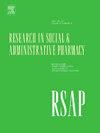将信息图表作为药学和制药科学的交流工具。
IF 3.7
3区 医学
Q1 PUBLIC, ENVIRONMENTAL & OCCUPATIONAL HEALTH
Research in Social & Administrative Pharmacy
Pub Date : 2025-03-15
DOI:10.1016/j.sapharm.2025.03.008
引用次数: 0
摘要
导读:与基于文本的摘要相比,信息图表可能更有效地传达科学研究。使用设计良好的信息图表可以将目标受众扩展到传统的学术圈子之外。目的:本研究的目的是比较信息图表与基于文本的摘要作为研究交流工具的有效性和浏览者体验。方法:在2024年初进行了一项仅限测试后的、参与者之间的数字化试点研究。来自药学或制药科学领域的参与者被随机分配查看同一篇研究文章的信息图表或基于文本的摘要。文章和信息图表均来自同行评议的期刊。调查项目由作者根据先前发表的研究设计,评估理解、回忆、有效性、认知(认知负荷)和注意力。卡方检验用于分析分类和顺序数据。采用非配对双侧t检验对连续数据进行分析。计算每个李克特量表的内部信度。排除标准包括少于300秒的回答和没有完成至少一篇文章的所有问题的回答。结果:最终分析的数据来自30个信息图表浏览者和16个基于文本的摘要浏览者。大多数参与者是来自美国的白人女学生,没有任何学习障碍。总体而言,在任何测量类型之间没有观察到统计学上的显著差异。一些信息图表在注意力和有效性项目上得分明显更高。讨论:在衡量注意力和有效性方面,一些信息图表可能比基于文本的摘要表现得更好。这项研究缺乏足够的力量,可能导致无法发现真正的差异。结果可能在人群中有所不同,包括非专家、神经发散型读者和母语不是英语的个体。结论:在向科学读者传达研究成果方面,信息图表可能并不比摘要更好。有必要进行进一步的调查,以了解如何最好地利用信息图表作为一种沟通工具。本文章由计算机程序翻译,如有差异,请以英文原文为准。
Infographics as a communication tool in pharmacy and pharmaceutical sciences
Introduction
Infographics may be more effective at communicating scientific research compared to text-based abstracts. Using well-designed infographics may expand target audiences beyond the traditional scholarly circles.
Aims
This study aims to compare the effectiveness and viewer experience of infographics vs. text-based abstracts as research communication tools.
Methods
A posttest-only, between-participants, digital pilot study was conducted in early 2024. Participants from the field of pharmacy or pharmaceutical sciences were randomized to view either infographics or text-based abstracts for the same research articles. Articles and infographics chosen were sourced from peer-reviewed journals. Survey items, designed from previously published research and by authors, assessed understanding, recall, effectiveness, cognition (cognitive load), and attention. Chi-square tests were used to analyze categorical and ordinal data. Unpaired two-sided t-tests were used to analyze continuous data. Internal reliabilities were calculated for each Likert scale. Exclusion criteria included responses recorded in less than 300 seconds and responses that did not complete all questions for at least one article.
Results
Final analysis included data from 30 infographics viewers and 16 text-based abstracts viewers. Most participants were white, female students from the United States without any reported learning disabilities. Overall, there were no statistically significant differences observed between any measure type. Some infographics had significantly better scores on attention and effectiveness items.
Discussion
Some infographics may perform better than text-based abstracts on measures of attention and effectiveness. The study lacks sufficient power, potentially resulting in failure to detect true differences. Results may differ in populations including non-experts, neurodivergent readers, and individuals whose first language is not English.
Conclusion
Infographics may be no better than abstracts at communicating research findings within an audience of scientific readers. Further investigation is warranted to understand how to best leverage infographics as a communication tool.
求助全文
通过发布文献求助,成功后即可免费获取论文全文。
去求助
来源期刊

Research in Social & Administrative Pharmacy
PUBLIC, ENVIRONMENTAL & OCCUPATIONAL HEALTH-
CiteScore
7.20
自引率
10.30%
发文量
225
审稿时长
47 days
期刊介绍:
Research in Social and Administrative Pharmacy (RSAP) is a quarterly publication featuring original scientific reports and comprehensive review articles in the social and administrative pharmaceutical sciences. Topics of interest include outcomes evaluation of products, programs, or services; pharmacoepidemiology; medication adherence; direct-to-consumer advertising of prescription medications; disease state management; health systems reform; drug marketing; medication distribution systems such as e-prescribing; web-based pharmaceutical/medical services; drug commerce and re-importation; and health professions workforce issues.
 求助内容:
求助内容: 应助结果提醒方式:
应助结果提醒方式:


